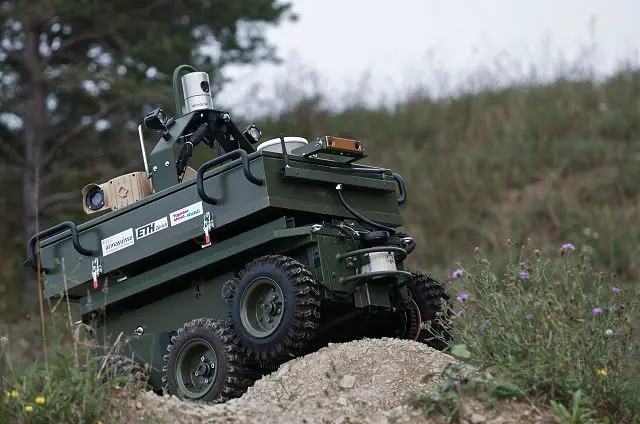The
international land robot trials, M-ELROB, is taking place in Switzerland
this year from 24 to 28 September for the first time; the host town is
Thun. As a technology partner of the Swiss Armed Forces and other international
customers, RUAG will be attending the event with the ARTOR (Autonomous
Rough-Terrain Outdoor Robot) and the Technology demonstrator based on
an EAGLE 4x4 featuring the RUAG Vehicle Robotic Kit presented in partnership
with specialists from universities and industry.
|
UGVs
(unmanned ground vehicles) – also known as land robots – are
used for protection or rescue duties in hazardous environments, or for
the performance of frequently reoccurring, repetitive tasks. The context
can be military as well as a civilian. UGVs are typically deployed for
reconnaissance work, monitoring buildings and infrastructures, border
surveillance, search and rescue missions and goods transport, as well
as explosive ordnance disposal and mine clearance. UGVs can be compared
to unmanned airborne systems, except that ground deployment presents scientists
and technicians with challenges that are several orders more complex and
difficult.
RUAG Defence CEO Urs Breitmeier comments: "UGVs are a highly promising
technology of the future, and one that RUAG is actively pursuing. RUAG
is researching, developing and investing in this area with the aim of
gradually becoming a UGV competence centre for the Swiss Army and other
security forces."
RUAG is attending this year's M-ELROB, which is taking place in Switzerland
for the first time, with two projects:
ARTOR (Autonomous Rough-Terrain Outdoor Robot) research project
ARTOR is a research project involving a group of specialists from the
Federal Institute of Technology Zurich (ETHZ), from technical departments
at armasuisse, and RUAG. The objective of this project is to improve the
autonomy of a ground vehicle. The point of the UGV research programme
as a whole is the setting up of a UGV competence centre in Switzerland.
The programme is primarily driven by Switzerland's public safety and security
requirements, not by the marketing possibilities presented by the technology.
ARTOR is already capable of navigating autonomously: rather than use GPS,
it relies on data captured by sensors mounted on the vehicle. ARTOR is
able to negotiate static and moving obstacles as its picks out the quickest
way to its target via a number of via predetermined waypoints. It is also
able to follow vehicles or people and can search for a route or area autonomously.
Two vehicular devices have been developed, both featuring electric propulsion:
one is a wheeled vehicle approximately 100 cm long and 80 cm wide weighing
250 kg with a payload capability of 100 kg. The other is a tracked vehicle
approximately 170 cm long and 80 cm wide weighing 425 kg with a payload
capability of around 200 kg. Maximum speed for both exceeds 15 km/h. The
average deployment time on a single battery charge is in the order of
four hours. Depending on what is required of them, the vehicles can rapidly
be equipped with a range of standard payloads.
Technology demonstrator based on an EAGLE 4x4 featuring the RUAG
Vehicle Robotic Kit
This project is a joint venture involving RUAG and General Dynamics European
Land Systems (GDELS), and is aimed at developing a UGV technology demonstrator
based on a standard military vehicle that is otherwise normally manned.
In the partnership, GDELS is delivering the Eagle 4x4 vehicle with an
all-important vehicle assistance system, while RUAG is responsible for
integrating the additional equipment required for UGV operation, such
as sensors, control computers (hardware and software), actuators, the
broadband radio system and the control and command equipment for the control
console. The vehicle is currently teleoperated, i.e. operated under remote
control, but its autonomy will improve as development work progresses.
RUAG is developing and delivering most of the UGV component groups in
kit form. The kit is designed in such a way that it can be used with almost
any vehicle. In addition, the control console can be installed in a container
or another vehicle. The vehicle can be operated in a manned or manned
mode. It measures 5.5 m in length, 2.3 m in width and 2.4 m in height.
Its maximum weight is 10,000 kg and it can carry a payload of around 3000
kg. |




















